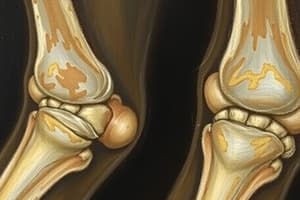Podcast
Questions and Answers
What is Osteoarthritis also known as?
What is Osteoarthritis also known as?
wear-and-tear arthritis
What are common symptoms of Osteoarthritis? (Select all that apply)
What are common symptoms of Osteoarthritis? (Select all that apply)
- Swelling (correct)
- Fever
- Pain/aching (correct)
- Fatigue
Osteoarthritis is caused by an active response of chondrocytes in the articular cartilage.
Osteoarthritis is caused by an active response of chondrocytes in the articular cartilage.
True (A)
What condition is caused by the accumulation of urate crystals in the joint? Gout is caused by the accumulation of ______ crystals in the joint.
What condition is caused by the accumulation of urate crystals in the joint? Gout is caused by the accumulation of ______ crystals in the joint.
What are risk factors for Gout? (Select all that apply)
What are risk factors for Gout? (Select all that apply)
What can Liposarcoma in the arms and legs cause?
What can Liposarcoma in the arms and legs cause?
What symptoms can Liposarcoma in the abdomen cause?
What symptoms can Liposarcoma in the abdomen cause?
What cells are affected by Fibrosarcoma?
What cells are affected by Fibrosarcoma?
What can happen when fibrosarcoma strikes the body's fibroblasts?
What can happen when fibrosarcoma strikes the body's fibroblasts?
What are possible risk factors for developing soft tissue sarcomas like fibrosarcoma?
What are possible risk factors for developing soft tissue sarcomas like fibrosarcoma?
Flashcards are hidden until you start studying
Study Notes
Osteoarthritis (OA)
- Also known as "wear-and-tear" arthritis, occurring due to aging and joint overuse
- Most commonly affects weight-bearing joints
- Causes:
- Damage or breakdown of cartilage between bones
- Joint injury
- Age
- Gender (women > men)
- Obesity
- Genetics
- Symptoms:
- Pain/aching
- Stiffness
- Decreased flexibility
- Swelling
- Diagnosis:
- Physical examination
- Imaging tests (X-ray, MRI)
- Lab tests (blood, synovial fluid)
- Pathophysiology:
- Progressive loss of articular cartilage and remodelling of the underlying bone
- Involves degradation of cartilage and remodelling of bone due to an active response of chondrocytes
- Treatment:
- No specific cure, but its effect can be reduced
- Control pain
- Maintain or improve joint function
- Maintain a normal body weight
- Achieve an overall healthy lifestyle
Gout
- Type of inflammatory arthritis
- Caused by a robust inflammatory response to uric acid crystals
- Occurs in hyperuricemia (high uric acid levels in the blood)
- Causes:
- Accumulation of urate crystals in joints
- Diet (meat, seafood, beverages, and alcohol)
- Obesity
- Medical conditions (certain diseases increase risk of gout)
- Certain medications (thiazide diuretics for hypertension)
- Family history of gout
- Age and sex (more common in males)
- Recent surgery or trauma
- Symptoms:
- Intense joint pain
- Inflammation and redness
- Limited range of motion
- Pathophysiology:
- Liver produces uric acid, which is eliminated through kidneys
- High levels of uric acid in blood lead to hyperuricemia
- Uric acid crystals form in joints, causing inflammation and pain
- Diagnosis:
- Joint fluid test
- Blood test (measure level of uric acid and creatinine)
- X-ray imaging
- Ultrasound
- Dual energy CT scan
- Treatment:
- Medications for pain and inflammation (Colchicine, Corticosteroids, NSAIDs)
- Medications for lowering uric acid levels (Allopurinol, Febuxostat)
- Lifestyle changes (limit purine-rich foods, avoid sugar, lose weight, consider pineapple)
Soft Tissue Tumors
- 3 types of soft tissue tumors: benign, intermediate, and malignant
- Benign tumors:
- Do not invade nearby tissue
- Do not spread to other parts of the body
- Examples: lipomas, neurofibroma, schwannomas
- Intermediate tumors:
- May grow and invade nearby tissues and organs
- May not spread to distant sites
- Examples: dermatofibrosarcoma protuberans, fibromatosis
- Malignant tumors:
- Can spread to other parts of the body
- Examples: soft tissue sarcomas (e.g. angiosarcoma, liposarcoma, fibrosarcoma)
Soft Tissue Sarcomas
- Can develop in soft tissues like fat, muscle, nerves, fibrous tissues, blood vessels, or deep skin tissues
- Can occur in any part of the body, but most common in arms and legs
- Examples:
- Angiosarcoma: malignant neoplasm in vessels, showing signs of hemorrhage and necrosis
- Liposarcoma: rare type of cancer that begins in fat cells
- Fibrosarcoma: rare type of cancer that affects fibroblasts, responsible for creating fibrous tissue
Studying That Suits You
Use AI to generate personalized quizzes and flashcards to suit your learning preferences.




